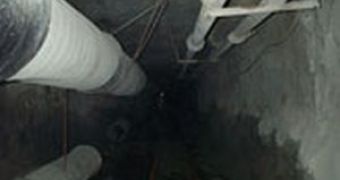In a South African gold mine, two miles beneath the Earth's surface, scientists have found an isolated, self-sustaining, bacterial community living under extreme conditions. This is the first microbial community proved to depend exclusively on geologically produced sulfur and hydrogen.
There are also other communities of "chemoautotrophs" ("chemical self-nourishment" in Old Greek) found in places like aquifers, petroleum reservoirs, and deep-sea volcanoes. Yet these communities all depend at least on an energy source.
The South African subterranean microorganisms, a type of Firmicutes bacteria, use radioactive uranium to convert water molecules into molecules used to get energy. Uranium is an abundant source of energy.
This finding raises the possibility that similar microorganisms could live beneath the surface of other planets. Li-Hung Lin at the Carnegie Institution's Geophysical Laboratory explained: "We know how isolated the bacteria have been because our analyses show that the water they live in is very old and hasn't been diluted by surface water. In addition, we found that the hydrocarbons in the local environment did not come from living organisms, as is usual, and that the source of the hydrogen (H2) needed for their respiration comes from the decomposition of water (H2O) by radioactive decay of uranium, thorium, and potassium."
The bacteria were found in a water-filled fracture of the mine, close to Johannesburg. Sampling the water, they noticed it contained hydrogen and hydrocarbons that form when water exposed to radiation from rocks containing uranium breaks down. Analyzing the age of the water and the microbes, they discovered that these bacteria split off from their surface relatives 3 to 25 million years ago. The surface ecosystems use energy achieved from the Sun, photosynthetic plants initiating the food chain, but in dark places life has to find other energy sources.
It is not known how surface bacteria managed to survive so deep in the Earth. But they capture energy and they could support other microbial communities with the energy achieved from uranium. Genetic analysis showed that there is very little species diversity in the underworld community. The dominating type of bacteria is related to surface bacteria that use sulfur compounds reduction to get energy. "We also believe that the sulfate used by these creatures is left-over from ancient groundwater mixed with ancient hydrothermal fluid. We can detect that because the chemical signature arises from interacting with the fracture's wall rock," commented Douglas Rumble from Carnegie Institution.
"It is possible that communities like this can sustain themselves indefinitely, given enough input from geological processes. Time will tell how many more we might find in Earth's crust, but it is especially exciting to ponder whether they exist elsewhere in the solar system."

 14 DAY TRIAL //
14 DAY TRIAL //